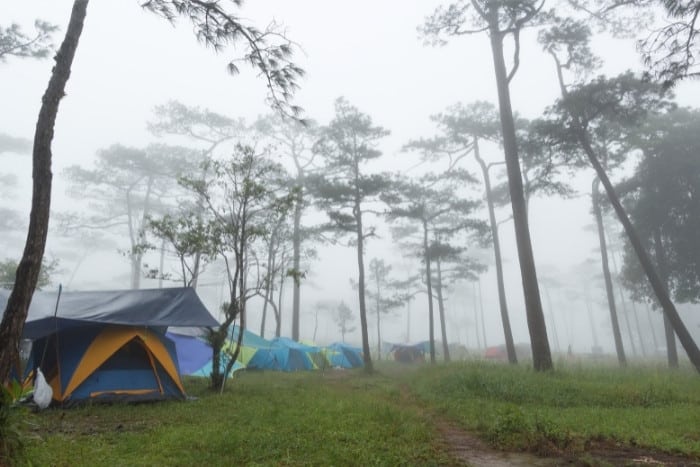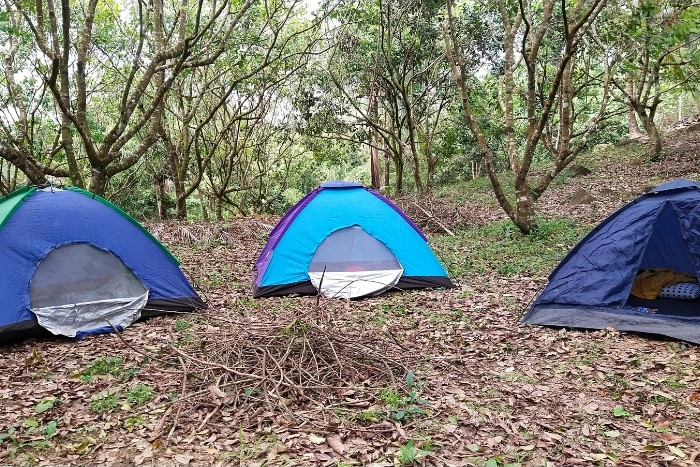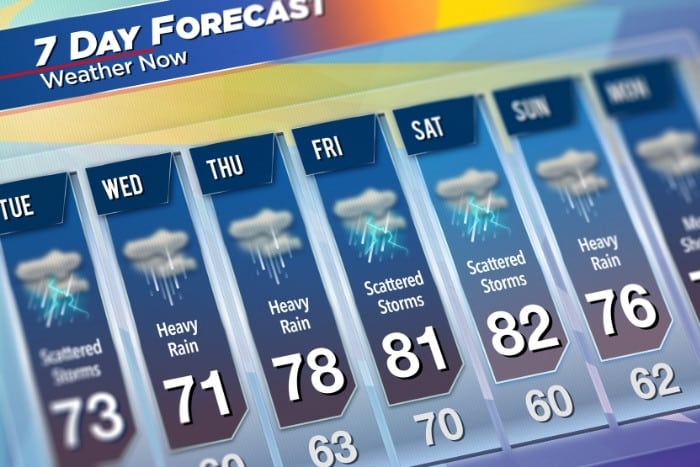You want to camp, but the weather forecast calls for some extreme weather. When the forecast calls for lightning, you need to know what risk it poses to your safety and whether you’ll be adequately prepared in just your tent. Unfortunately, you might not like the answer.
Tents can be hit by lightning, particularly if they are Bell tents or have metal poles. Look for tents with carbon fiber or plastic poles. Avoid placing the tent near trees, an open field, or open water. Always seek shelter in a developed building when possible instead of staying in a tent.
If you’re curious about how safe you’ll be in a tent and how you can decrease your odds of being struck by lightning, here’s what you need to know.
Will Lightning Hit Your Tent While Camping?
If you intend to camp and know that the forecast calls for rough weather, you might wonder just how safe you’ll be inside your tent.
The bad news is that your tent offers no real shelter from lightning.
Even if you have limited options for where you can stay during a storm, a tent is often way down on the list of potential shelters.
Older tents have metal or aluminum poles that can act as a lightning rod.
You’ll want to avoid Bell tents with one pole down the center that serves as a great conductor of electricity in a storm.
If you camp in an area known for extreme weather, you can purchase more modern tents with plastic or carbon fiber poles that aren’t as well-known for conducting electricity.
Lightning is also more likely to hit tall objects, so be sure to position your tent appropriately if you’re camping during a thunderstorm.
You won’t want to be the tallest thing in the field. This often means you can’t camp above the tree line or on a ridge.
Always make sure something is going to be taller than you are. Of course, these aren’t the only considerations when camping during a storm with lightning.
Here are a few things that warrant some caution during a storm.
1. No Such Thing as a Safe Tent
You’ll need to come to terms with the fact that there’s no such thing as a safe tent during a lightning storm.
Being in the wrong area, such as above the tree line or in the middle of an open field, can have serious consequences.
A tent simply isn’t capable of protecting you from lightning, even if you opt for one with carbon fiber or plastic poles.
While you can do a few things to minimize your risk of having your tent hit by an errant bolt of lightning, you’ll still be at risk as long as you’re in the tent.
You can ensure that your guy lines are securely fastened and that your rain tarp is hung, but that’ll do little to protect you from lightning in a storm.
The best thing to do is seek the right campsite and get out of the tent for safer shelter if possible.

2. Best Shape and Fabric
Much like no lightning-safe tent, it won’t matter much what your tent is made of unless it has metal or aluminum poles.
Lightning is just as likely to hit your tent, no matter what it’s made of or what shape it is.
The only exception is Bell tents (which have the pole in the middle) that often act as a lightning rod.
Apart from this exception, lightning can hit any tent you’ll find at an outdoor store. All fabrics and shapes are susceptible to lightning.
The most important thing is where you position your tent, which we’ll talk about in the next sections.
It’s possible to minimize your risk of being hit with a few smart moves while setting up your tent.
3. Keep Tents Away from Trees
While you don’t want to be the tallest in the area, you also want to steer clear of being too close to trees. The risk of being near the trees is twofold.
You might face a side flash, or you could be injured by a tree that’s struck by lightning.
Side flash is the term for when lightning will strike one object, followed by a current jump to some other object.
In this instance, the tree may be struck by lightning, which can jump on you or your tent.
This phenomenon is extremely dangerous and highly likely if you’re too close to a very tall object that’s likely to attract lightning.
On the other hand, a tree that’s struck by lightning might explode at the point of contact.
This can mean branches and limbs fall off completely, leading to injury for anyone under them.
If you’re camping near trees, make sure you aren’t camped under “widowmaker” trees with dead branches or limbs barely hanging on.
They are likely to come free in a rough storm and could result in injuries.
4. Seek Shelter
For those who don’t feel safe braving the storm in a tent, you might want to seek shelter. One of the best places to find shelter from a storm is in a bathroom.
Make sure you take refuge in an area that has electricity or plumbing – in other words, a developed building. This is the only safe way to seek shelter.
Avoid shelters with no electricity or plumbing because they won’t be able to ground the flash if they’re hit.
While they might keep you dry, they aren’t going to offer anything in the way of protection.
Examples of ungrounded buildings include picnic shelters, outhouses, and gazebos. What do you do if there’s no safe place to seek shelter?
The first thing you need to do is leave your tent. The odds are high that your tent will attract lightning if it has old-school metal poles.
Get away from any places with high elevation, stay away from trees and other tall objects, and get into a ravine or depression.
Make sure that it won’t be prone to flash flooding. Generally, a bigger ravine or depression is less likely to flood with torrential downpours.
If you’re near your car, you can also take shelter here.
Keep your hands off the steering wheel, but you can feel free to recline your seat and take a nap while you wait out the storm.
The car acts as a Faraday cage that conducts the electricity around the outside of the car without any impact on you inside.
5. Avoid Ground Strike in Your Tent
While many people are quick to do their best to avoid being hit directly by lightning, there’s another danger that isn’t considered: ground strike.
In a ground strike, lightning hits the ground and can travel 30 to 100 feet away from the strike point.
If you’re riding out the storm in your tent (which may be ill-advised), you need to protect your body from being affected by the ground strike.
This means you should never lay directly on the ground during a lightning storm.
Instead, keep a foam sleeping pad beneath your sleeping bag. You can also use any other insulating item to keep the ground strike from harming you.
You might think you can avoid a ground strike by hanging out in a hammock that elevates you above the ground.
They’ll protect you from ground strikes, but they could pose other problems. A hammock is too close to trees that could injure you or could lead to a side flash.
6. Space Out Your Tents
Camping is a great activity with a group of friends, but you won’t want to stay too close to them during a lightning storm.
Multiple tents in one small area are more likely to be hit and conduct electricity, particularly if they’re the tallest in an open field.
Spreading out also has another benefit. It means there is less risk of everyone becoming injured by a direct hit.
This enables the remaining unaffected parties to call for help if it’s needed by someone who was directly hit.
If tents are too close, side flash can also occur as the current jumps from one tent to the next.
Keeping some distance between tents and campsites is essential to prevent everyone in the party from becoming injured.

7. Keep Your Tent Away from Water
Camping during extreme weather means a few things you’ll need to avoid if you want to minimize your risk of being injured due to lightning.
While finding dry ground might be difficult, you want to avoid standing in water. Wet ground is fine, but pools of standing water are unsafe.
Water is a known conductor for electricity, and a strike anywhere nearby may travel from the water to your body.
When choosing your campsite, forego convenience and park yourself far away from ponds, lakes, and rivers.
8. Avoid Metal
You also want to avoid touching anything metal, even if it doesn’t seem tall enough to be struck by lightning on its own.
It can conduct any kind of electricity in the area, leading to burns and other types of injuries. Get away from anything metal if you can.
9. Protection with Caves
If you can’t find a building to take shelter in and you’re too far from your car, it’s best to leave your tent in favor of a cave.
However, you will need the cave to be deep enough to offer some protection from lightning.
What’s a rule of thumb for safe caves during a storm, and which ones should be passed over?
The only way a cave offers a safe shelter is if you can’t see the entrance from your position inside.
Anything that’s too shallow still runs the risk of being hit by lightning, affected by a side flash, or dealing with a ground strike.
10. Seek Shelter Even If You Don’t See Lightning
One of the biggest mistakes inexperienced campers make is not seeking shelter if they don’t see lightning.
You may not often notice the quick lightning strike in the midst of a heavy storm.
Any time extreme weather starts to roll in, you should automatically get in the habit of seeking shelter.
A good rule is to seek shelter anytime you hear thunder.
Once the thunder rolls make their way into your eardrums, you know there’s a chance of lightning.
They often go hand in hand, and it is much easier to listen for thunder than to watch for a bolt of lightning.
11. Staying in Your Tent
If you are determined to remain in your tent during a storm, you must take as many precautions as possible.
Spread out a tarp on the floor to help absorb nearby ground strikes. Sit on a sleeping pad, sleeping bag, and anything else you have that doesn’t contain metal.
Don’t touch the tent itself or any pieces of metal that could conduct electricity (like the zippers).
While sitting in the tent, you’ll want to make your body as small as possible. Curl up in a tiny ball, as small as you possibly can.
At the same time, you’ll need to figure out how to sit to touch as little ground as possible.
The more your body comes in contact with the ground, the more likely you will feel the effects of the ground strike.
You should also keep your boots on, even inside of your tent.
Lightning is more likely to affect you if it hits your bare feet instead of being conducted through your hiking boots.
While you may have been raised to take your shoes off before you go inside, this is one rule you’ll want to break when camping in a lightning storm.
With some of these precautions, you can remain in your tent and avoid lightning damage. However, you should only stay here if you have no other safe places to take shelter.
12. Keep Tabs on Weather
If you know that lightning is likely, try to keep it near your camp or any nearby shelter.
This isn’t when you’ll want to venture out for a long hike, a picnic on the other side of the mountain, or anything that takes you too far from your safe spots.
Keep tabs on the weather by coming prepared with an NOAA radio that can warn you when extreme weather is rolling into your nearby area.
This is an essential item in your toolkit for when lightning is in the forecast.

Final Thoughts
Lightning can indeed hit your tent, especially if it has metal poles.
However, you can do a few things to limit the likelihood of having your tent hit by lightning, such as placing it away from open fields and staying below the tree line.
Camping in extreme weather may be unavoidable if you’re determined to take a trip, but you can minimize your risk with these helpful hints.
